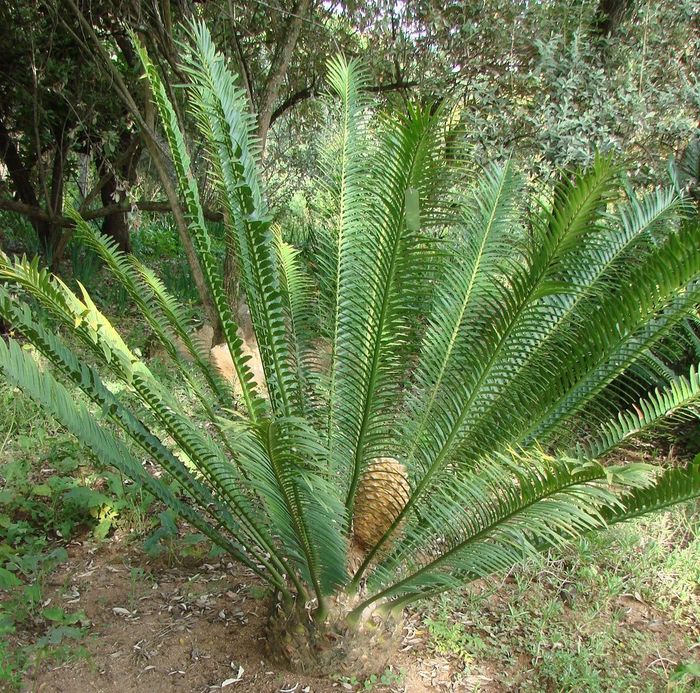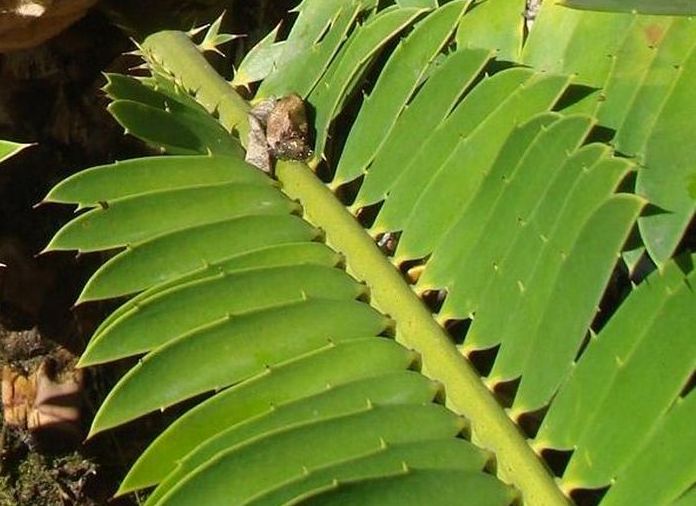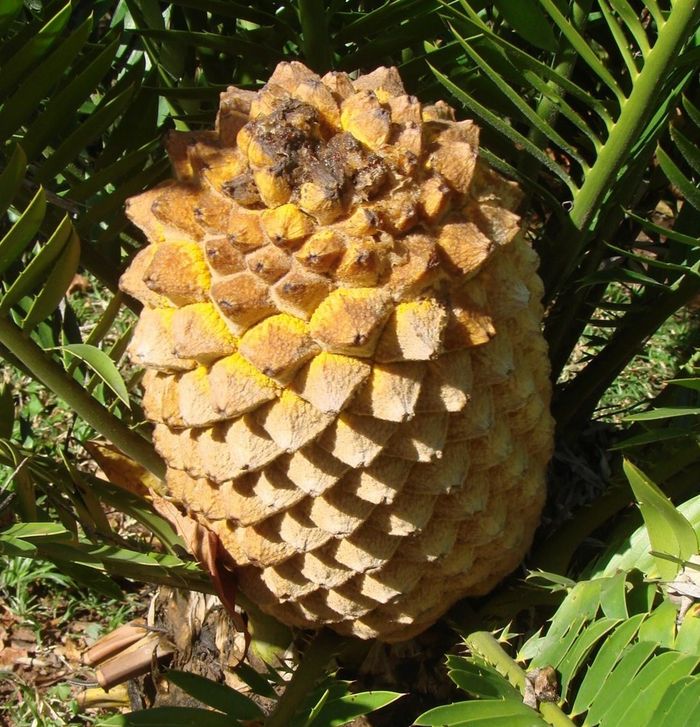Encephalartos aemulans
Encephalartos aemulans Vorster
Family: Zamiaceae
Common names: Ngotshe cycad (Eng.); ngotshe-broodboom (Afr.)
SA Tree No: 14.5
Introduction
An extremely rare cycad, which is endemic to South Africa, and known from a single mountain in the Vryheid District, in KwaZulu-Natal. Female and male cones are similar, which is one of the main characteristics used to distinguish it from other closely related cycads.

Description
Description
Encephalartos aemulans is a medium-sized cycad. The stem is erect and unbranched, usually producing basal suckers. It can be up 1.5 m tall and rarely up to 3 m and 350 mm in diameter, and has a densely woolly crown. Leaves are medium sized, 1.2–1.5 m long and rarely 2 m long, rigid, straight, the upper side is a glossy dark green and lower side is slightly duller and lighter.

The petioles are short, only 70–110 mm long. Leaflets narrow, very slightly tapering at both ends, 125–150 mm long and 16–18 mm wide.

Leaflets shield one another slightly at the leaf apex and in the middle of the leaf, but not at the basal part of the leaf blade. Basal leaflets are spaced 25–30 mm apart and are reduced to a series of spines, which almost reach the leaf base. Margins slightly curved (clearly visible in dried, rather than fresh leaves), with 1–3 teeth on the upper margin and 1 or 2 on the lower margin .The apex of successive leaflets are not in a single straight line.

Cones of both sexes are very similar in size, shape and appearance. They are sessile, the crown covered with brown wool and 2–4 cones per stem. Male cones are rounded, becoming more elongated when mature, and lemon-yellow underneath the woolly layer, 220–380 mm long and 140–180 mm in diameter and are produced in midsummer (January), with pollen shedding in autumn (March–May). Female cones are rounded, green underneath the woolly layer, 350–410 mm long and 200–410 mm in diameter. Seeds are covered with bright red flesh.
Conservation Status
Status
This is a rare species that occurs almost completely at a single location. More than 90% of the mature individuals occur in a single subpopulation on a hill slope, on a privately owned farm, and 2 old male plants have been recorded about 10 km away. According to the Red List of South African plants website, the conservation status of this species is Critically Endangered (CR). The population is believed to have declined substantially in the 1980s, but the extent of decline is difficult to quantify. Estimates of the numbers of remaining plants vary from 150–250. Seedling regeneration in habitat seems to be very successful, however, the reserve is not secure against poachers and the owner believes that plants are still disappearing.
Distribution and habitat
Distribution description
This cycad is known from one population in the Vryheid District, at an altitude of 1 000 1 100 m. Two old male plants were located 10 km away, but no further populations were found. The plants are commonly found on south-facing sandstone cliffs, in short grassland where they are fully exposed and in humus-rich scree below the cliffs, where especially small plants were found underneath scrubby vegetation, under more shady conditions.

Derivation of name and historical aspects
History
This species was previously popularly considered to be a form of Encephalartos natalensis and was commonly known as the ‘woolly natalensis’, until it was described as a new species in 1990, by Piet J. Vorster. Encephalartos is Greek for ‘bread in head’ and refers to the floury, starchy material in the trunks of some species, which is eaten as famine food by local people. The species name aemulans comes from the Latin word meaning ‘resembling’, which refers to the similarity of the male and female cones.
Cycads are grouped into 3 families: Cycadaceae, Stangeriaceae and Zamiaceae. Currently there are about 343 cycads recognized worldwide. Cycads are found in the tropical, subtropical and warm temperate regions of Africa, Asia, Australia, and North, and Central America. South Africa has 38 species of cycads, all in the genus Encephalartos of the family Zamiaceae, and one Stangeria.
In the absence of cones, it is difficult to distinguish this species because it can easily be confused with E. lebomboensis, E. msinganus, some forms of E. natalensis, and E. senticosus. They can be distinguished as follows:
In E. msinganus the female cones have a thin, felt-like, brown hairy outer layer that covers and somewhat obscures the cones, which are initially greenish yellow, but turn brighter yellow when mature. The male cones are hairless.
In E. lebomboensis neither the male nor the female cones are ever woolly and have a smooth surface, in comparison with the cones of E. senticosus, which have a rough outer surface. Leaflets are less than 25 mm wide.
In E. natalensis female cones initially have a dense, dark brown to reddish brown woolly coating; male cones are hairless, and leaflets broader than 25 mm, dentate, boat-shaped, with thick margins.
In E. senticosus the cones have a rough outer surface. The female cones initially have a dense dark brown woolly surface layer, which disappear almost completely when mature and the male cones are hairless. Leaflet margins tend to be slightly curved then thickened.
Ecology
Ecology
For a long time it was thought that all cycads were wind pollinated, as most coniferous plants are, and the fact that cycads generally produce high volumes of pollen, supported this argument. However, research has shown that insects are the pollinators of cycads. Most cycads are thermogenic (able to produce heat) and emit volatile odours. In nature when the male cone reaches maturity, the central axis elongates and the scales move apart to make room for the release of the pollen, which is transported by insects. The release of pollen usually lasts for 18 days. When the female cone reaches maturity, the cone will heat up, causing it to elongate, and it produces a smell which attracts the insects to the female cone The scales move apart to allow the insects to enter and to pollinate the cone.
Uses
Use
In Zulu culture, most of the cycads are referred to as isqgiki–somkhovu. This name refers to witchcraft practices, where a person is converted into becoming a zombie and is used for witchcraft. The cycad is planted in front of the gate of the homestead to protect it from the evil spirit. If someone practices any witchcraft using umkhovu, this zombie will sit on top of the cycad, which is referred as isqgiki, which means ‘chair’, and that is where the common name is derived from.
This species has been collected long before it was described and for that reason it is common in private collections. The numbers of wild species have declined. In one location active seedling regeneration is taking place, however, the wild population is very small, as this species occurs in one location.

Growing Encephalartos aemulans
Grow
This cycad grows best in semi-shade or full sun. This species will tolerate light frost and is a fast grower when planted in sandy soil.
Encephalartos aemulans is propagated by seed and suckers. Sow seed in river sand and place on a heated bench at 24–28ºC. Germination should start 3 weeks after sowing. However, some seeds will take longer, especially where there is no heat. At the one-leaf stage of development, the seedlings are susceptible to infection by the fungus that causes damping off.
Most cycads produce basal growths, known as pups or suckers. These are small vegetative offsets that are genetically identical to the mother plant. The best time to remove a sucker is in early spring (July–September), during the dormant period.
When a sucker reaches a size of about 80 mm diameter, dig the soil away from around the main cycad to expose the sucker and clean any dirt from the sucker and the main cycad. Use a sharp, clean, cutting tool such as a saw, chisel or knife to cut off the sucker. Make a clean cut at the point of attachment of the sucker to the main plant. As a precaution, especially to valuable species, apply fungicide, sulphur or a tree seal to the cut area, on both the sucker and the mother plant, to prevent disease and attacks by pests.
If the sucker is large enough (minimum of 250 mm) and it has enough roots, it is best to immediately plant it straight into the ground. Smaller suckers and suckers with no roots of their own must be taken to the nursery, where they should be left in a cool, dry area to dry for a few weeks, to allow the wounds to form a callus, before potting.
References
- Africa cycads, species of South Africa, Encephalartos aemulans Ngotshe Cycad. Accessed 4 August 2019. http://africacycads.com/species.php?id=2.
- Cycad friends, cycad database, Encephalartos amulans. Accessed 4 August 2019, http://cycadfriends.co.za/site/cycad-database/encephalartos/encephalartos-aemulans/
- Grobbelaar, N. 2002. Cycads with special reference to the southern African species. Published by the author, Pretoria.
- Jungle music palms and cycads, Encephalartos aemulans. Accessed 4 August 2019, http://www.junglemusic.net/Encephalartos_Species/Encephalartos_aemulans.html .
- Ulwazi, sharing indigenous knowledge. Isihlahla sesigqiki somkhovu. https://www.ulwaziprogramme.org/2016/10/isihlahla-sesigqiki-somkhovu/ Accessed on 2019/04/26.
- Vorster, P. 1990. Encephalartos aemulans (Zamiaceae), a new species from northern Natal. South African Journal of Botany 56(2): 239–243.
Credits
Lungisani Zondi
Walter Sisulu National Botanical Garden
September 2019
Acknowledgements: images by Willem Froneman, Lowveld NBG.
Plant Attributes:
Plant Type: Shrub
SA Distribution: KwaZulu-Natal
Soil type: Sandy, Loam
Flowering season:
PH:
Flower colour:
Aspect: Full Sun, Morning Sun (Semi Shade), Afternoon Sun (Semi Shade)
Gardening skill: Average
Special Features:
Horticultural zones









Rate this article
Article well written and informative
Rate this plant
Is this an interesting plant?
Login to add your Comment
Back to topNot registered yet? Click here to register.